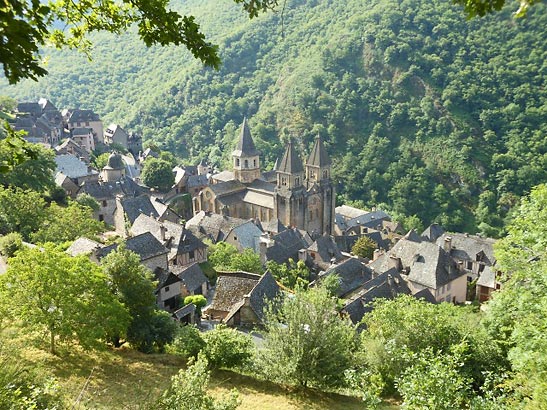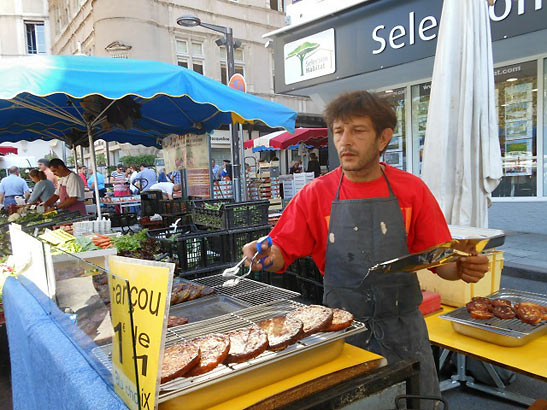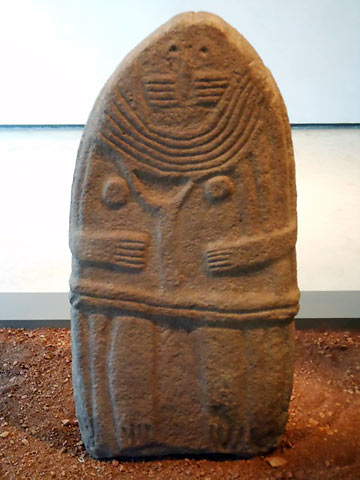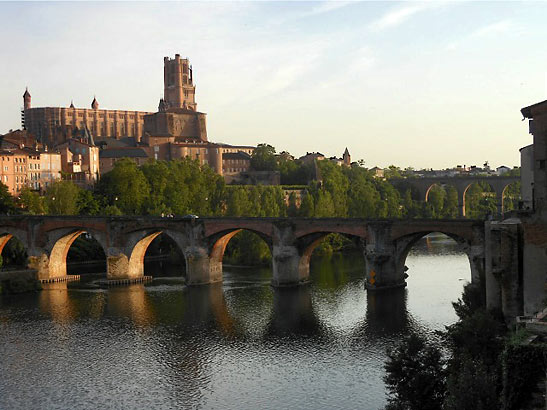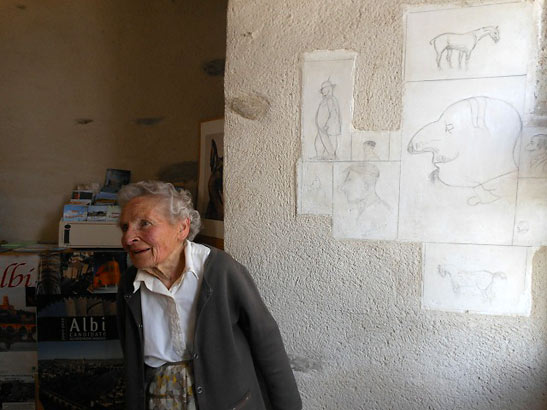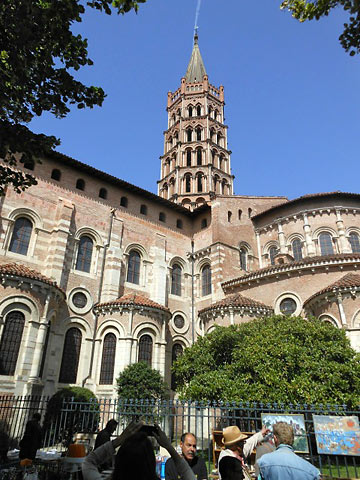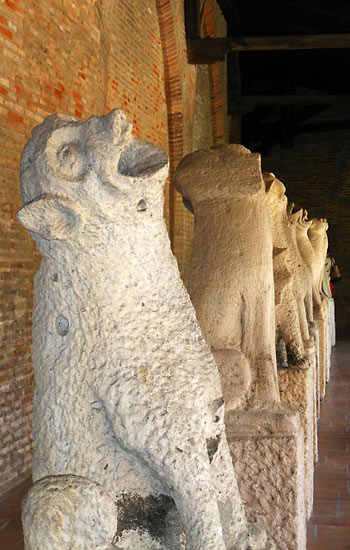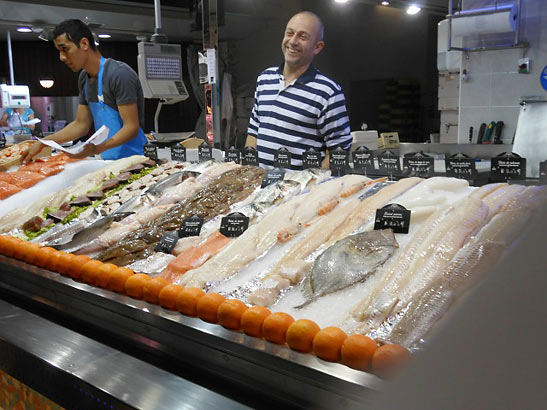 |
 |
|
 |

|
Art Ancient and
Contemporary
In Southwestern France Story and Photos by Corinna Lothar
Conques Today, pilgrims continue along the same route via the exquisite village of Conques, now as then a major stopping point for pilgrims. They are recognizable by their walking staffs and the scallop shell attached to their backpacks. A German couple, who spend their summer holidays on the long trek from Cologne to western Spain, explain that each year they walk part of the route, until they finally reach the town where the apostle James is said to be buried.
Conques, classified as one of the most beautiful villages of France, has not changed much over the centuries. Its lovely half-timbered houses tumble down steep lanes behind the magnificent abbey of St. Foy. As dusk falls gently on the surrounding hills, Brother Jean Daniel, one of a handful of monks charged with keeping the abbey, lectures visitors about the 12th century tympanum depicting the Last Judgment. He invites his audience into the cathedral for an impromptu organ concert as the last rays of the setting sun illuminate Pierre Soulages’ 20th century windows. It’s a moment of timeless magic. The abbey’s treasury is filled with jewel encrusted, golden reliquaries, including one said to have been a gift from Charlemagne. Just outside the village, the Domaine de Cambelong, a hotel and restaurant owned by Herve Busset, is not only a lovely place to spend the night, but chef Busset prepares outstanding meals. His hotel is what visitors dream of: the charming little country inn with haute cuisine prepared by a master chef. The occasion for my visit to this region of France was the opening of the brand new Soulages museum in Rodez, a small provincial town near Conques, and the recently renovated Toulouse-Lautrec museum in Albi, one of the Midi Pyrenees’ most impressive medieval towns. Rodez and Pierre Soulages Rarely does a city build a new museum honoring a single living painter, but Rodez built a museum, designed by a Catalan firm of architects, to house some 500 of the the 94 year old artist’s works. Soulages, who was born in Rodez, calls it an “unusual” museum, unusual in its steel walls and floor, in the large, light filled rooms and the smaller, darker ones, and its restaurant reflecting Soulages’ interest in light. Michel Bras, whose restaurant in Laguiole earned him three Michelin stars, and his son, Sebastien, are responsible for the fine cooking in the museum’s restaurant. Aside from the Bras restaurant in the Soulages Museum, Isabelle Auguy is the chef-owner of a first class restaurant in the outskirts of town. Her elegant, modern restaurant overlooks the verdant country-side. At the Rodez twice-weekly farmers’ market, you can find “gateau a la broche” (cake on a stick), which resembles the Bavarian Christmas “Baumkuchen” (tree cake). It is sliced horizontally and baked in layers that look like rings on a tree. Legend has it that the cake was brought to the Aveyron region from Germany by Napoleon’s army. “Fouace,” a yeast cake resembling a brioche, is another ubiquitous Aveyron specialty. Vendors at the Rodez market sell “aligot” a regional specialty of mashed potatoes mixed with a little cream, garlic and local Laguiole cheese, and spicy vegetable pancakes called “farcous.”
Rodez is a medieval city with an imposing pink cathedral and a center of narrow streets lined with shops and restaurants. A shop in the center of town sells the region’s famous Laguiole knife, invented iin 1829 by the son of a local innkeeper, who brought a knife with a curved blade back from Catalonia. The Laguiole knife is hinged with a spring closure. The Fenaille Museum in Rodez has an outstanding collection of pre-historic carved stones called “menirs.” They are mysterious and enigmatic, dating back some 5,000 years, and the first time that human beings are represented in sculpture. Albi and Toulouse-Lautrec Albi is dominated by the huge 13th century fortress-cathedral St. Cecile. The Albigensian heresy was a movement that flourished in southern France in the 12th and 13th centuries. The Albigenses, or Cathars, believed in the forces of good and evil with the material world considered as evil; they were eradicated by the Pope and the king of France. The cathedral was a reminder to the people of the power of the church and the king.
Albi’s medieval quarter consists of half-timbered houses on narrow streets. A lovely garden restaurant awaits hungry visitors. The family-owned Clos Sainte Cecile is located in what was once a school and is close to the cathedral. An 11th century bridge spans the Tarn river leading to the newer parts of town where visitors can delight in the Academy of Miniatures, a “museum” of doll-house size 19th century rooms, constructed by Annie Juarez whose son-in-law now runs the little museum-cafe. On the same right bank is another small museum dedicated to the 18th century French explorer of the Pacific, Jean-Francois de Laperouse. The renovated Toulouse-Lautrec museum is located in the 13th century archbishop’s palace. The extensive collection includes the posters that made Henri, born in Albi in 1864, famous. A few miles outside Albi in Camjac is the Chateau du Bosc where Toulouse-Lautrec spent much of his childhood. The castle is open to the public and tours are given by the painter’s distant cousin, a delightful old lady who shows a visitor the drawings Henri made on the castle’s whitewashed walls and tells animated tales of the his childhood.
Albi’s wealth in the 14th and 15th centuries was built on the dark green leaves of a small plant which flourished in the region: woad – the French call it “pastel” – used to make an indelible pale blue dye. Toulouse soon took over preeminence in the woad trade, and from the mid-15th to mid-16th centuries, the merchants of the city built fabulous mansions with towers that served no purpose other than to show off wealth and good fortune. Prosperity came figuratively crashing down when cheaper indigo arrived from India. Today, in a minor renaissance, woad is again being cultivated for the production of cosmetics.
Toulouse, art and cuisine Toulouse, France’s fourth largest metropolis, is said to be “pink at dawn, red at noon and mauve at dusk.” Toulouse is a university town and the center of France’s aerospace industry. The old, central part of town is graced with red brick buildings and amusing towers. The great central square in front of the imposing 18th century “Capitole” (City Hall) is a center of civic activity. The city is famous for its violets, the first flower to grow in winter, and shops sell everything from violet sweets to scents. Violets were brought from Italy by Napoleon’s soldiers, and the thrifty Toulouse merchants sold them all over France and Europe. Today, there are 10 producers. The city has many museums, including the fine art Augustin museum housed in a former convent, its cloister guarded by a display of fierce gargoyles. The 16th century Renaissance Hotel d’Assezat houses the Bemberg collection of art; the modern art museum is located in the former slaughterhouse on the bank of the Garonne.
One of the splendors of Toulouse is the former Dominican church with its beautiful murals, stained glass windows and ribbed vaults, especially the 22-branch palm tree vault in the apse. The large St. Sernin Romanesque basilica was built in the 11th and 12th centuries to accommodate all those pilgrims. There’s a lively flea market outside the church on week-ends. While Paris remains France’s number one dining destination, with Lyon considered a close second, Toulouse has its share of first class restaurants. Toulouse is known for its cassoulet, a soul-satisfying rich stew of white beans, duck, pork, vegetables and sausages, but restaurants also offer far more sophisticated fare. Chef Michel Sarran’s two star restaurant bearing his name, for example, is elegant both in decor and in the presentation of complex haute cuisine. The chef incorporates the best in local produce, game and fish into his unique dishes. Le Bibent, a brasserie on the central Place du Capitole, is a marvel of art nouveau decor, dating to 1882. The food is innovative and delicious, the surroundings magnificent. Michel Bras has opened a unique “fast food” cafe-restaurant in the center of Toulouse, called Le Capucin signe Bras. Bras serves a variety of sandwiches in pancake-like “bread,” called “capucins” because they resemble the Capuchin monks’ hoods. An unusual Toulouse neighborhood restaurant is Chez Navarre, where patrons sit at tables shared with strangers, and help themselves to a French home-style buffet of hot and cold dishes. The fare changes daily but there are always half a dozen salads and three or four main dishes, soup and, of course, cheese, and dessert. Foie gras is a regional specialty. At Restaurant Emile, a diner can splurge on a first course of pate de foie gras with mango chutney, followed by ravioli filled with foie gras in a scrumptious mushroom sauce. The rest of the duck, grilled or in a cassoulet, is available as well. Touloouse has several covered markets. The 120 year old Victor Hugo market has over 100 stalls and houses not only an extraordinary array of fruits, vegetables, cheeses, meat and wines, but also stalls selling foie gras, black pork sausages and fancy ice creams. There are several lively bars in the market. The smaller, Carmes market, is equally interesting and filled with beautiful produce. Like the Victor Hugo market, its nineteenth century metal structure has been replaced by concrete.
Midi Pyrenees region is famous for a number of specialties, including Roquefort, the sharp blue cheese, which is sold in differing degrees of sharpness, and the wines of Marcillac. A peculiarity of the region are the bastides, fortified villages, usually round, built by the French and English in the thirteenth and fourteenth centuries. In exchange for protection from the reigning lord, the villagers would promise fealty. Cordes sur Ciel is one of the earliest, high up on a hilltop. It’s a trek up the cobble-stoned streets to the village, but worth the climb. One of the local legends holds that a dragon lived in the hill and prevented construction of the village. So the local people called on St. Michael for help; he slew the dragon and Cordes was built. It is called Cordes-sur-Ciel because at certain times of the year, the cloud cover is below the village, which then sits above the clouds. Regardless of whether you have come to this region of France for business, for pleasure, or as a pilgrim, there are delights awaiting you. If You Go: Should you be returning home on Air France, and happen to be lucky enough to be in business class, you just might get a slice of foie gras with your dinner. It’s a little piece of France to take home (as long as you eat it before you get to U.S. customs). Air France, which flies from several American cities nonstop to Paris, has a premium economy class of service between economy and business, which is almost as good as business but considerably cheaper. Grand Hotel de l’Opera in Toulouse is an excellent, elegant, old fashioned hotel with splendid views of the Capitole square. The Domaine de Cambelong in Conques is highly recommended for its charm and superb cuisine. In Albi, the Hotel Mercure offers lovely views of the old city, has a good restaurant and offers fresh self-squeezed orange juice at breakfast. The Mercure chain is reliable for clean, business style rooms and service throughout the region. For more information, contact www.tourism-midi-pyrenees.co.uk Related Articles: |
|
I found a Mich Goss J. Grassmayr Innsbruck bell with Jesus,
a crucifix and a flower on it. Do you have any information about it you can
share with me? Many thanks. I don't have any information on that specific bell. If she wants information, "Liz" in San Bernardino should contact the factory. Here is the information: Address Grassmayr Foundry and Bell Museum, Leopoldstrasse 53, Inssbruck, A-6010 Austria. Telephone: 43 512-59416-0. Fax: 43 512-59416-22. E-mail: johannes@grassmayr.at or info@grassmayr.at. Corinna
Been there -- thought I'd done it -- you proved me wrong. Great travel coverage -- even for those who have lived there. --- Bill, Redmond, Oregon
Corinna, my dear, What a wonderful series of words you have collected together to paint a mesmerizing story about one of my favorite places. Even though I've traversed these same locales as you many times, your delightful descriptions made me want to book a flight this very second and see again some of the places that time did not allow me to linger in before. Your photos are also riveting, and I loved the pantyhose one - what a clever, sexy way to promote that article of the female form. Your colorful words make the entire region literally come alive before my eyes - a rare gift for any writer! Bravo and again Congrats on your top notch feature. Best regards. Best regards,
Hello Corinna, This is very roundabout ... I was recently teaching (Legal Reasoning) in Kabul and encountered Ann Geracimos, who said she knows you from the Times. She recently provided me with an electronic version of your 2007 piece about returning to Frankfurt (which I enjoyed very much). Jonelle and I are well (and enjoying our 3 grandchildren, who live within blocks of our house). I hope you are well. I will now look for your travel writing regularly. Best regards,
What an amazing background Ms. Lothar has! I enjoyed her article
very much. I found it to be quite intriguing, especially the interpreter school
bit.
I loved your article on Metz. I was an exchange student living there from 1981-1982 and have always felt like Lorraine was the most overlooked part of Europe. You really captured the feel of the city with your photo and articles.
|
This site is designed and maintained by WYNK Marketing. Send all technical issues to: support@wynkmarketing.com







